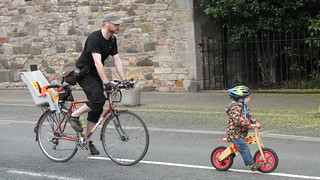This was in a Sunday Herald supplement, don't think it made it on-line.



"
Suzanne Hitchell adds a touch of flower-power to one of her recycled bikes
Photograph: Martin Shields
THE UPCYCLERS
WHY BUY A NEW BIKE WHEN YOU CAN RESCUE A VINTAGE CLASSIC FROM THE SCRAPHEAP? BY SUSAN SWARBRICK
SUZANNE Hitchell is introducing her
bicycles. There's Deborah, a sleek racer
that she rescued from a drug user who
had "acquired" the bike. And Angie,
a town bike with a looped frame and
flowery basket. "I found her on eBay a
few years back," she says of the latter.
Together the bikes have a collective age of around 80
- and that's the way Hitchell likes it.
She is part of a growing band of Scots who are eschew-
ing brand-new bikes in favour of embracing a vintage
revolution and upcycling old contraptions that might
previously have ended up on the scrapheap.
"I couldn't imagine buying a new bike," she says.
"Everything in my house is vintage. I have always cared
about the environment. There are enough second-hand
bikes in the world that we don't need to buy new. I prefer
an old bike."
Hitchell, 42, from Rutherglen, Lanarkshire, took up
cycling four years ago after becoming worn down by a
soul-sapping daily commute. "I got sick and tired of
driving," she says. "It would take me so long to get to work
every day. I would sit at traffic lights and feel envious of
cyclists whizzing past on their bikes. I decided enough
was enough: I was going to get myself a bike too."
Then fate intervened. Hitchell was working as a
community warden in Glasgow when she saw a young
woman pushing a bike along a city centre street. "It was
clear she had been using drugs and didn't even look like
she could cycle," says Hitchell. "Straight away I had a
sinking feeling she might have stolen it.
"Thinking on my feet, I said: 'That's a lovely old bike,
were you about to hand it over to us?' and she replied:
'Uh, yeah, I was just on my way to hand it in. I found it
lying over there.'"
After the police collected the bike, Hitchell used social
networking sites to try to track down the owner. "Six
weeks later I enquired to see if the bike had been reunit-
ed with its true owner but was sadly still unclaimed. The
officer I spoke to said I could take it home," she says.
"Deborah is a gorgeous wee bike that someone had
clearly loved and looked after, but when I got her the chain
was hanging off and she had two flat tyres. After a sendee
she was perfect. I added a daisy garland and panniers."
While Deborah is for everyday use, Hitchell uses her
second bike, Angie, for more leisurely jaunts. Her musi-
cian husband and three children aged 19,14 and four,
are all keen cyclists, and the family's make-do-and-niend
approach sees them recycle everything, from clothes and
toys to furniture. They also grow vegetables and keep
three chickens for eggs. "It's like the Good Life - our
neighbours call us Tom and Barbara," laughs Hitchell.
When people ask her advice on buying a bicycle, Hitch-
ell directs them to The Bike Station, the UK's largest bike
recycling charity, which has bases in Glasgow, Edinburgh
and Perth. The organisation takes any unwanted or dis-
carded bikes, regardless of age or condition. They then
then patch them up to sell on, or reuse and recycle the
Thorn Wall started cycling four years ago to get away from a monotonous commute
Photograph: Martin Shields
parts. Since opening two years ago, the Glasgow branch
alone lias refurbished and sold almost 4000 bikes.
"I have donated two of my daughter's bikes to The
Bike Station and believe that's the way forward," says
Hitchell. "That's where I tell people to look first. The
website Gumtree is good too, as are car-boot sales.
Cycling's popularity is going through the roof at the
moment, but I would always suggest people think about
goto g for an old bike rather than automatically buy new.
By choosing second-hand you are helping to save the
planet by cutting down on carbon emissions and saving
;i bike h um ending up in landfill."
Sophie Kromholz, a 24-year-old art historian and
Glasgow University PhD student, wholeheartedly
agrees. "I don't believe in buying new bikes because it's
just not the done thing in the Netherlands where I grew
up; she says. "As a small child I got a new pink bicycle
forChristmas, but all the others throughout my life have
been < iwned bv other people before me."
Growing up in Maastricht, cycling was a way of life. "I
biked to school, nil my friends and teachers used bikes,"
she says. "It's practical and just what you do. It's only
really people who do a lot of big hills or go racing who
buy specialist bikes. If you are simply cycling around
town, there is no need for a fancy bike. There are so
many second-hand bikes available in the Netherlands."
When she came to Scotland, the first thing Kromholz
did was buy a bike: a Raleigh Calypso which she found
on Gumtree. "I'm not sure how old it is - at least 10 years
THE National Cycle Network (NCN) provides mainly traffic-free
routes for cyclists for 2000 miles across Scotland.
They includes NCN754 along the Union and Forth and
Clyde Canals from Edinburgh to Bowling; NCN77, known
as the Salmon Run, which follows the the Tay from Dundee
to Pitlochry; and NCN1 from Aberdeen to John o' Groats,
Orkney and Shetland.
In Glasgow the NCN75 provides a means to traverse the
city centre away from busy traffic, while taking in the iconic
sights of the Clyde. Due to open this spring is the long-
awaited cycle path over the "bridge to nowhere" over the M8
that will link Central Station and the west end.
Other routes under development include NCN78, a 64-
mile route from Fort William to Inverness, linked to a 53-mile
section from Oban to Fort William.
The Bike Station has made a map showing Edinburgh's
impressive network of off-road routes and online journey
planners can not only identify the quietest or quickest, but can
be used via a smartphone as a cycling sat nav.
CycleStreets.net has open-source mapping that is
constantly updated with the latest routes and infrastructure by
local cyclists; Google maps now has cycle journey planning.
As part of its Cycling Action Plan, the Scottish Government
has set a target of 10% of all journeys to be made by bike by
2020 - a number tied to its low-carbon and obesity strategies.
Just 1 % are currently made by bike.
Over the next two years, £6 million has been earmarked to
improve Scotland's cycle paths and train schoolchildren.
Yet with less than 1 % of the country's overall 2013/14
transport budget allocated to cycling, campaigners say more
investment is needed if we are to come close to matching the
Netherlands and Denmark, where cycling accounts for 27%
and 13% of journeys respectively.
In April, a Pedal on Parliament campaign saw thousands of
cyclists converge on Holyrood to lobby for improved safety on
Scotland's roads.
visit www. sustrans. org. uk and www. thebikestation. org. uk
SUSAN SWARBRICK
- and I chose it due to a combination of aesthetics and
because it's closest to what I grew up riding back home.
It's what we would call in Dutch 'omafiet' which means
'granny bike'. I find it more comfortable and it's easier
to carry things around with me."
Kromholz is reticent to be seen as a green crusader.
"I appreciate the environmental aspects, but more than
anything it's a practical means of getting about," she
says. "I think the biggest misconception about cyclists
is that we are all eco-hippies and have a political agenda.
Certainly a lot of people who cycle do fit that descrip-
tion, but there are so many other reasons to own a bike.
For me it's a lifestyle choice. I don't have a problem with
people who use cars, I just prefer a bike."
WHILE cycling is currently
undergoing a renaissance in
Scotland, Kromholz believes
much work is still to be done if
we are ever to emulate the suc-
cess of her native Netherlands
as a bike-friendly nation. "Peo-
ple are definitely becoming more aware and apprecia-
tive of cycling, but it takes time," she says. "In the Neth-
erlands there is a strong legal structure that protects
cyclists' rights that the UK doesn't currently have.
"I have to say my family was a little less excited when
they found out I'd got a bike in Scotland just because of
the lack of dedicated cycle paths. One of the first things
my mum did when she visited was buy me a bike bell the
size of a small grapefruit."
Embracing the vintage bicycle revolution for his own
reasons is Thorn Wall, 30, a Glasgow-based movie-prop
designer. Originally from Slane in County Meath. Ire-
land, he started cycling four years ago as an alterna-
tive to a monotonous commute by bus. "I figured a bike
would keep me fit," he says.
After buying a second-hand fixed-gear bicycle, Wall
decided to customise it to suit his tastes - a notion that
has since blossomed into a near obsession with stripping
down and rebuilding bikes. "The only thing I have left
of that original bike is the rear rim and wheel spokes,
everything else has been replaced," he smiles. "I buy
Sophie Kromholz grew up in the cycle-friendly Netherlands
new parts and the ones I don't need any more I pass on
to mates or sell."
In the current challenging economic climate, it's
a shrewd technique being adopted by many thrifty
cyclists. UI would love to have £5000 to spend on a per-
fect bike," he says, "but then you'd worry about it get-
ting broken or stolen. This way I can constantly upgrade
it, add bits here and there. It's a great hobby. Most of
my friends have a project bike taking up space in their
spare room or hall. I just finished a bike which I sold to
a friend. I was sad to see it go, but Fm already thinking
about the next one."
Buying new, believes Wall, can often be a false econ-
omy. "The frame I have on my current bike is 25 years
old - and it will last another 25 years if I look after it,"
he says. "You can't say that about a new bike. Most
aren't designed to last. They are mass produced using
the cheapest materials around. Unless you are spending
big bucks you aren't going to get quality.
"I spend a lot of time on eBay buying bits and pieces.
I just bought a new front-brake caliper for £15 that I will
keep and use at a later date. Fm hoping to build a track
bike at some stage and working on a design for a custom
frame. Fm always on the look-out for bargains and proj-
ects, things I can fix up. I have a wardrobe full of parts."
Wall now works as a freelance mechanic and cycle
trainer for The Bike Station, and has a side project
- dubbed 2nd Cycle Designs - making belts and accesso-
ries from recycled bicycle tyres and parts. He owns five
bikes he has built or is rebuilding from scratch.
"At first it was simply about getting from A to B but
it's now become a social thing too," he says. "If I have to
go a few days without getting on the bike I feel weird."
That's echoed by Hitchell. "If there are days I feel a bit
low, I simply put my jacket on and go out on my bike,"
she says. "I always feel uplifted afterwards. Getting a
bike is a bit like having a dog - you suddenly find people
want to come up and talk to you. One of the first times I
cycled my bike, Deborah, the chain came off. I was just
getting off to fix it when three cyclists stopped to help.
"I have at least 20 new friends I wouldn't have if I
hadn't got a bike. My life has been enriched since I took
up cycling."
BY NUMBERS
Over one million
more people in
the UK now cycle
regularly since
2008, including
100,000 in
Scotland.
Upwards of
10,000 people
took to the traffic-
free streets of
Edinburgh for this
year's Sky Ride in
September.
Since June
2012 more than
12,000 people
have signed up
to British and
Scottish Cycling's
social groups,
with 264 groups
already being
formed around
the UK, including
13 in Scotland. *
Since 2009,
Scottish Cycling
membership has
increased by
77%.
LET'S GET TO WORK
CYCLING Scotland operates a Cycle Friendly Employer
award that celebrates companies that provide the right
facilities and incentives to encourage their staff to cycle.
interest-free loans are available from the Energy Saving
Trust to help fund dedicated parking and changing facilities
for employees, while Cycling Scotland itself can provide
small grants to help with the purchase of pool bikes. They
also offer subsidised commuter training courses.
The nationwide Bike 2 Work scheme lets employees
save up to 42% on bikes bought through a salary sacrifice
scheme. This means people can buy a tax-free bike,
through their employer, and pay off the costs over a set
period through their salary. Because repayments are taken
at source, both employee and employer save on national
insurance and tax contributions.
Another benefit for employers encouraging a cycling-
friendly ethos is reduced travel costs: the recommended
rate for bikes is 20p per mile, much cheaper than driving
(40p per mile) or taxi fares.
Cycling Scotland recommends each workplace sets up
a Bicycle User Group (www.scotbug.com) and regularly
monitors staff cycling rates via the bi-annual Big Count
(www.bigcount.co.uk).
For more information, visit http://www.cyclingscotland.org

 posts
posts
